Where to put the sword; PARRIES, TRANSITIONS AND WARDS
If you do any historical fighting, you may hear the words Ward, Parry, and Guard (Guardia for Italian). I am going to use terms here that are mostly found in the Italian school, and spoken of by Saviolo, if not exactly referred to by him. To be consistent with exiting instructors, schools and other written resources, I would encourage reading works by Tom Leoni, Stephen Hand, Bill Wilson, among several other historical fencing authors such as you find. I'm not going to try an poach their work, nor am I going to show a definitive work up on all of the historical positions swords can be found in. I would wish anyone who does historical fighting to be familiar with the terms however.Earlier on Page II I use the four Agrippa positions, as they are great initial references of where to put a sword. The four hand positions are a constant through much of the era. I refer to them below
GUARDIA or GUARD Is the result of a defence being executed. It may be stood on, or passed through. Like a base in baseball. One can stand safely on the base, or run past it, but you have to touch on it as you move on to the next. Example: Defender makes a half tempo Falso Manco cut having started in Codelunga larga, beating the blade up and to the right outside, ending in Guardia Ditesta. That guard could remain, or be converted into a stoccotta, or a riverso or a dritto.
WARD Saviolo seems to refer to a ward as both a position in which to begin an engagement and an active defensive position. It's not an action, like how a guardia is somewhere a fencer ends up, rather it's the position they are in prior to the action. Saviolo teaches three wards in which to use. There are probably more, but he tried to simplify them. The wards also act much like a concept of how one is going to approach the fight, so they are more complicated than just a place to stand and see what happens from.
PARRY Is the action of removing the sword from being a threat. Moving from a ward to a guard, if the intent to remove the sword is the action, IS the parry. A parry can take many forms, have different tempo, etc.
TRANSITION For the sake of the work here, I'm going to use the term transition to express a change in state. A parry is a transition, so is removing from the fight, and coming back on line. An attack is equally a transition, moving from a ward, through a defensive action ending in a guard, then attacking as tempo dictates. Simply a transition is moving between one state and another. A cravasion is a transition, a parry is a transition, a contratempo action is a transition, as well as an attack. The problem here in fencing is that the vulnerabilities are in the transition. YOU ARE THE THE MOST VULNERABLE WHEN MOVING.
Here's a quick reference on guards, and wards. These pictures are not meant to be definitive. There may be several different definitions out there, so understand that there are better and more exact terms in use, and those experts can speak to the nuances. It's important to know that there are positions used, and if you have never heard of them, here is a general idea of what they look like. You can find definitions with more detail in Part IX Terms section.
| Guardias |  Guardia Alta: A guard with the sword straight up Guardia Alta: A guard with the sword straight up |
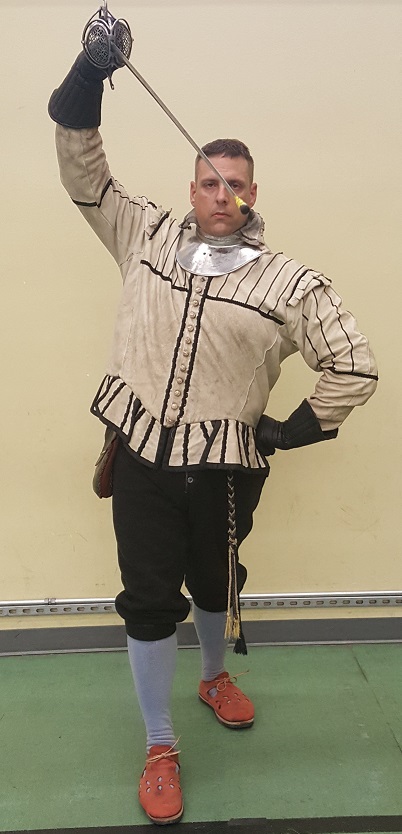 Guardia Alicorno: Basically prima Guardia Alicorno: Basically prima |
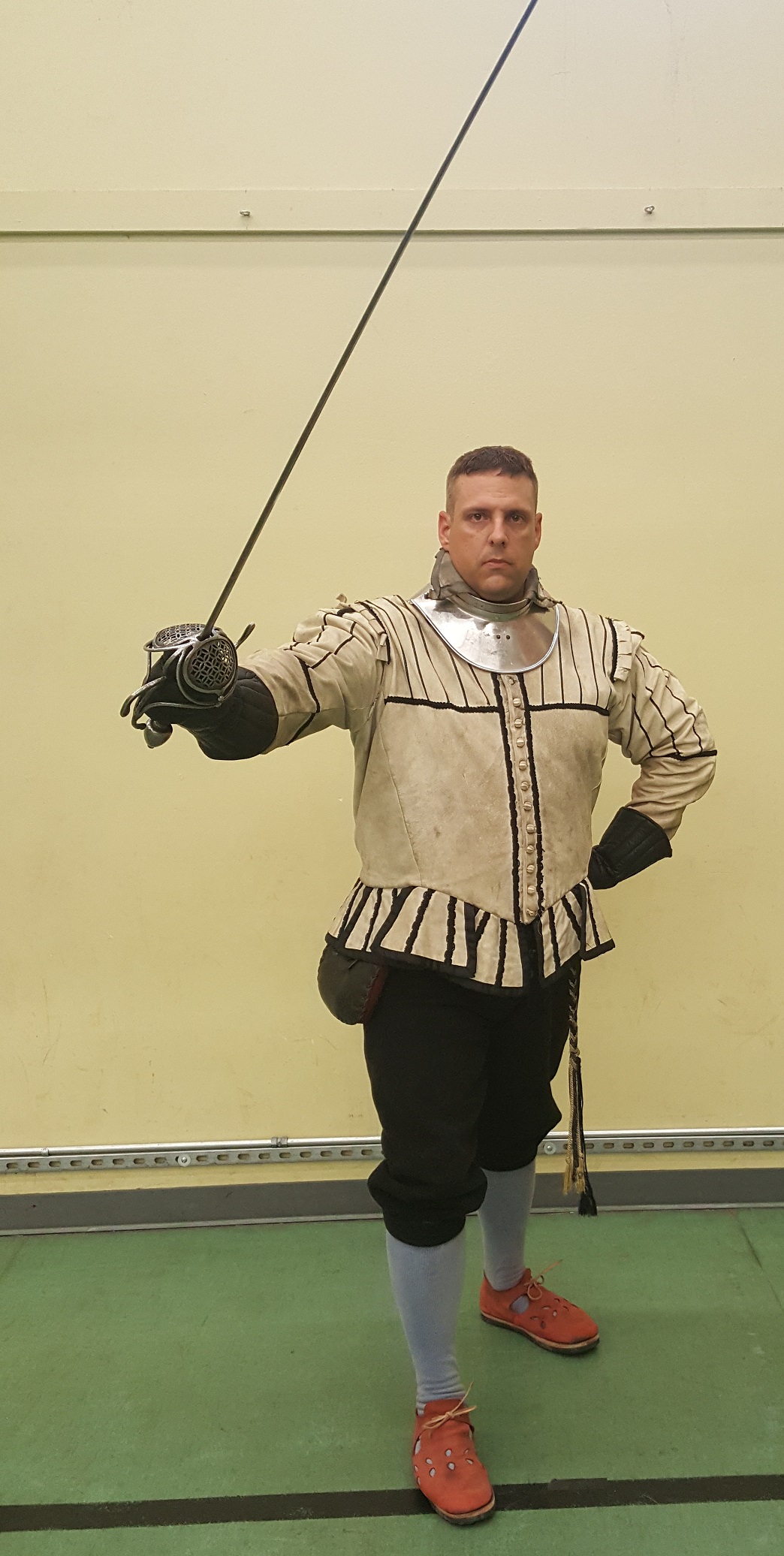 Guardia di Testa: Head guard. Showing the outside here, but there could be an inside to the left. Guardia di Testa: Head guard. Showing the outside here, but there could be an inside to the left. |
 Guardia d'intrare: A high secunda, with a an outside angulation Guardia d'intrare: A high secunda, with a an outside angulation |
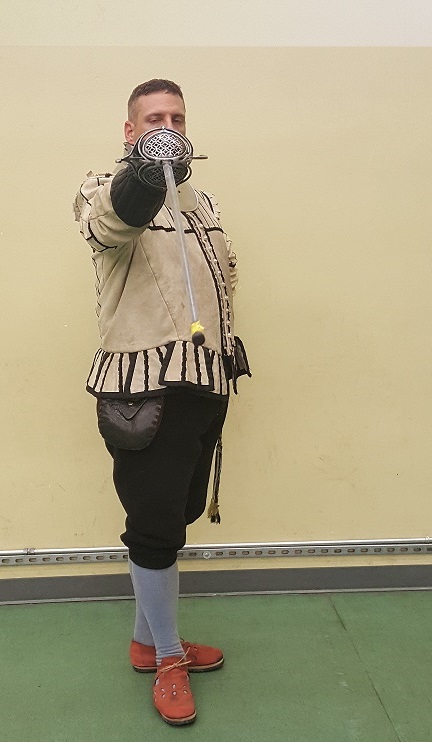 Guardia di Faccia: Sword in quarta straight out from under the face with arm fully extended Guardia di Faccia: Sword in quarta straight out from under the face with arm fully extended |
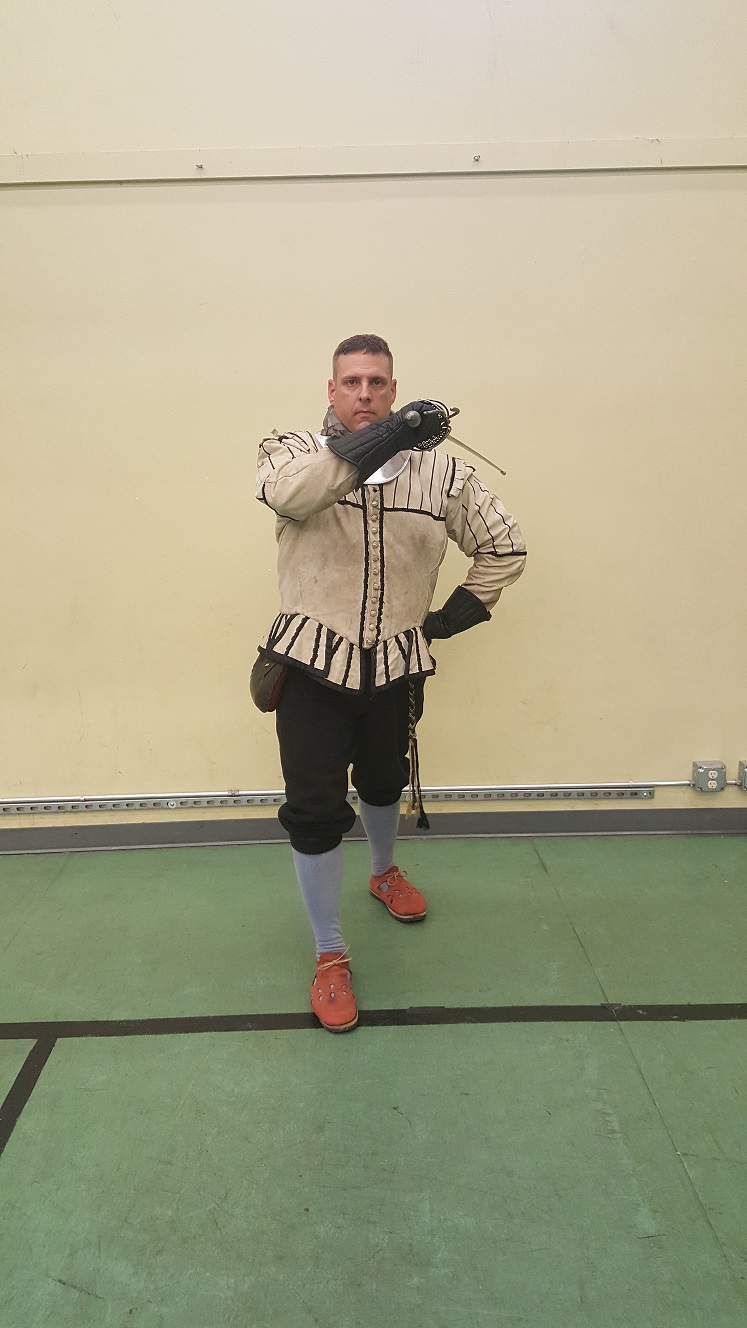 Guardia Sopra Braccio: Sword in secunda, laying over the opposite shoulder Guardia Sopra Braccio: Sword in secunda, laying over the opposite shoulder |
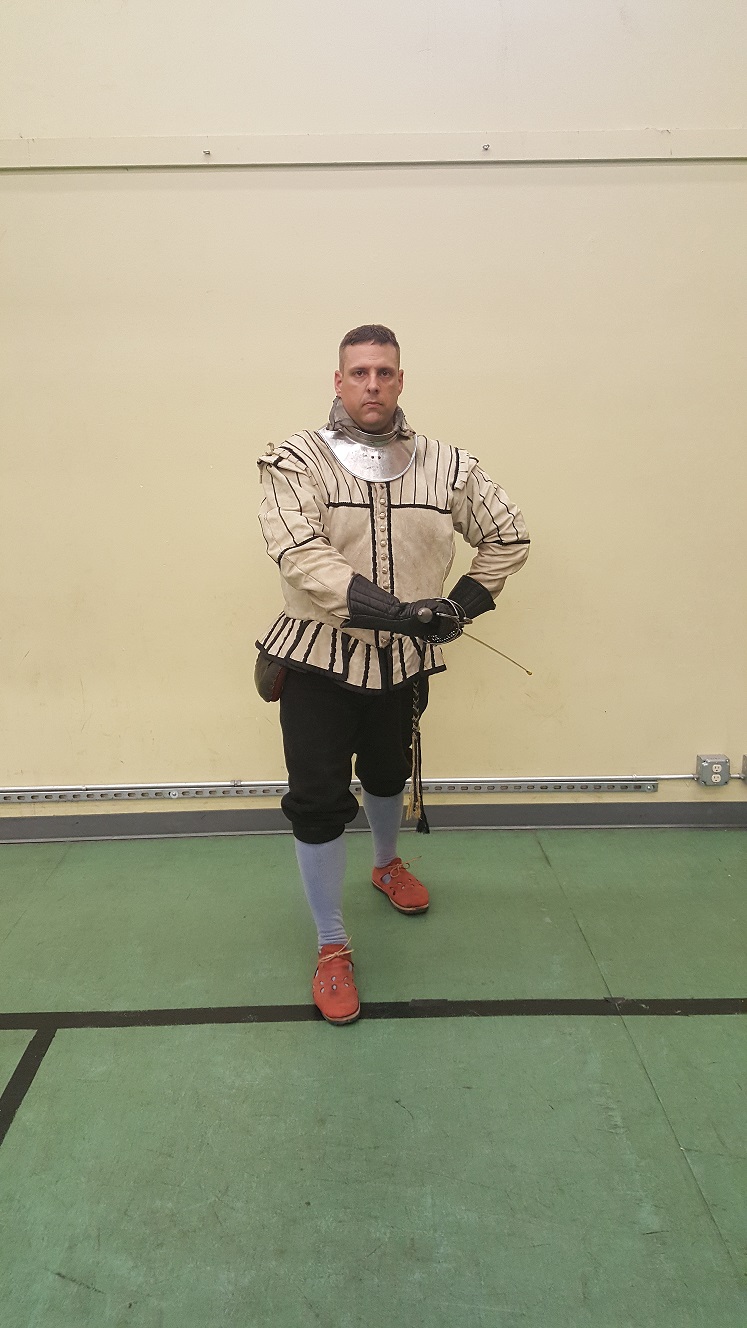 Guardia Sotto Braccio: Sword in secunda under the opposite arm Guardia Sotto Braccio: Sword in secunda under the opposite arm |
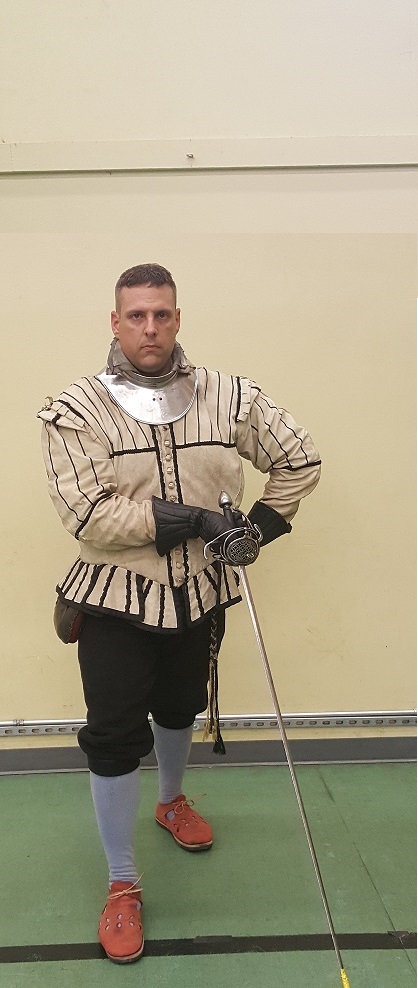 Guardia di Fianco: Sword in quarter, across the body true edge out Guardia di Fianco: Sword in quarter, across the body true edge out |
| Wards | 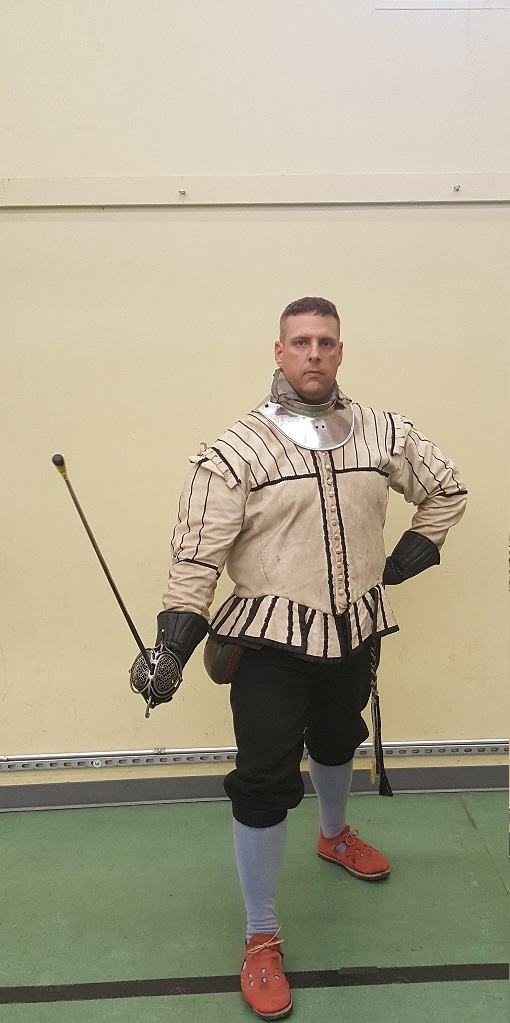 Code Lunga: Sword held outside right leg in a mutation of secunda/terza, comes in 3 varieties, High, Low, Short. Additionally, there is an extended, which is with the sword held behind Code Lunga: Sword held outside right leg in a mutation of secunda/terza, comes in 3 varieties, High, Low, Short. Additionally, there is an extended, which is with the sword held behind |
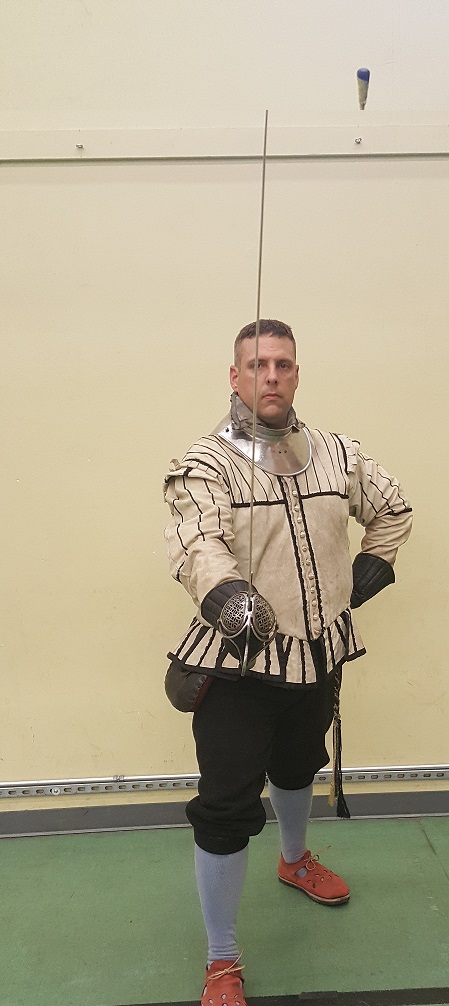 Porta di Ferro: Sword in terza in the middle of the thigh, also in three positions; high, short and long Porta di Ferro: Sword in terza in the middle of the thigh, also in three positions; high, short and long |
 Cinghiara Porta di Ferro: Sword held in mutation of terza/quarta, also in three positions; high, short and long Cinghiara Porta di Ferro: Sword held in mutation of terza/quarta, also in three positions; high, short and long |
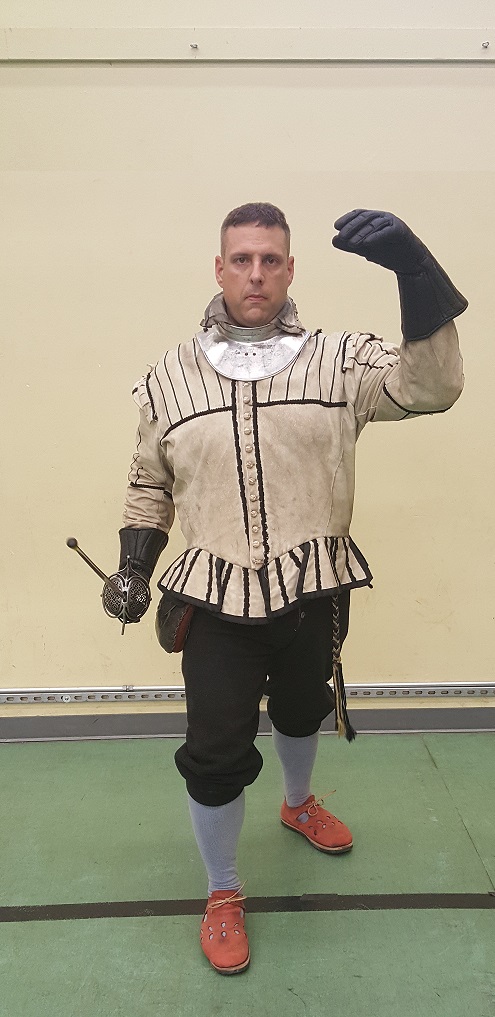 Broad Ward: Used by Saviolo, it's high up in terza at the hip Broad Ward: Used by Saviolo, it's high up in terza at the hip |
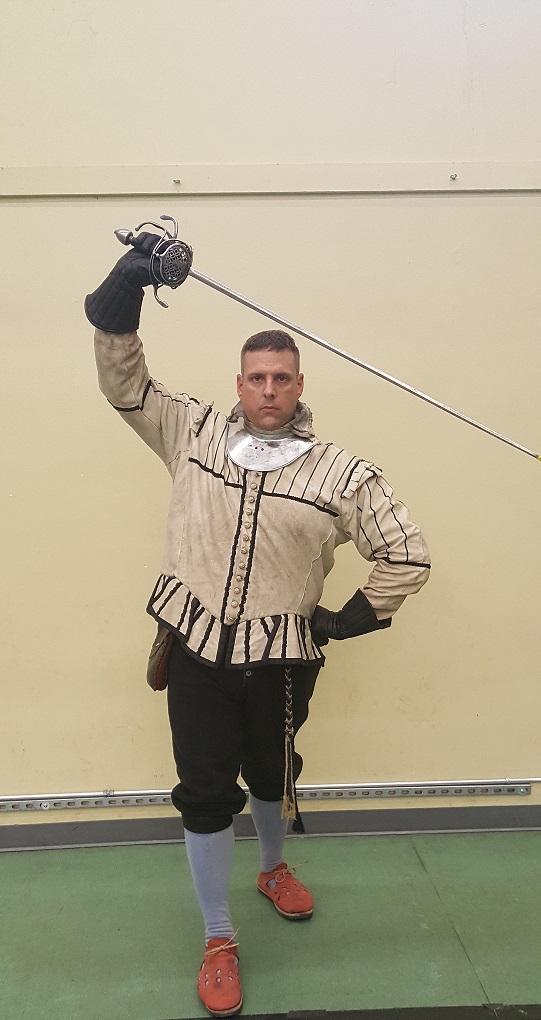 True Guard: from Silver, a variant of alicrono, meant to protect the head True Guard: from Silver, a variant of alicrono, meant to protect the head |
 Open Ward: Same as guardia alta Open Ward: Same as guardia alta |
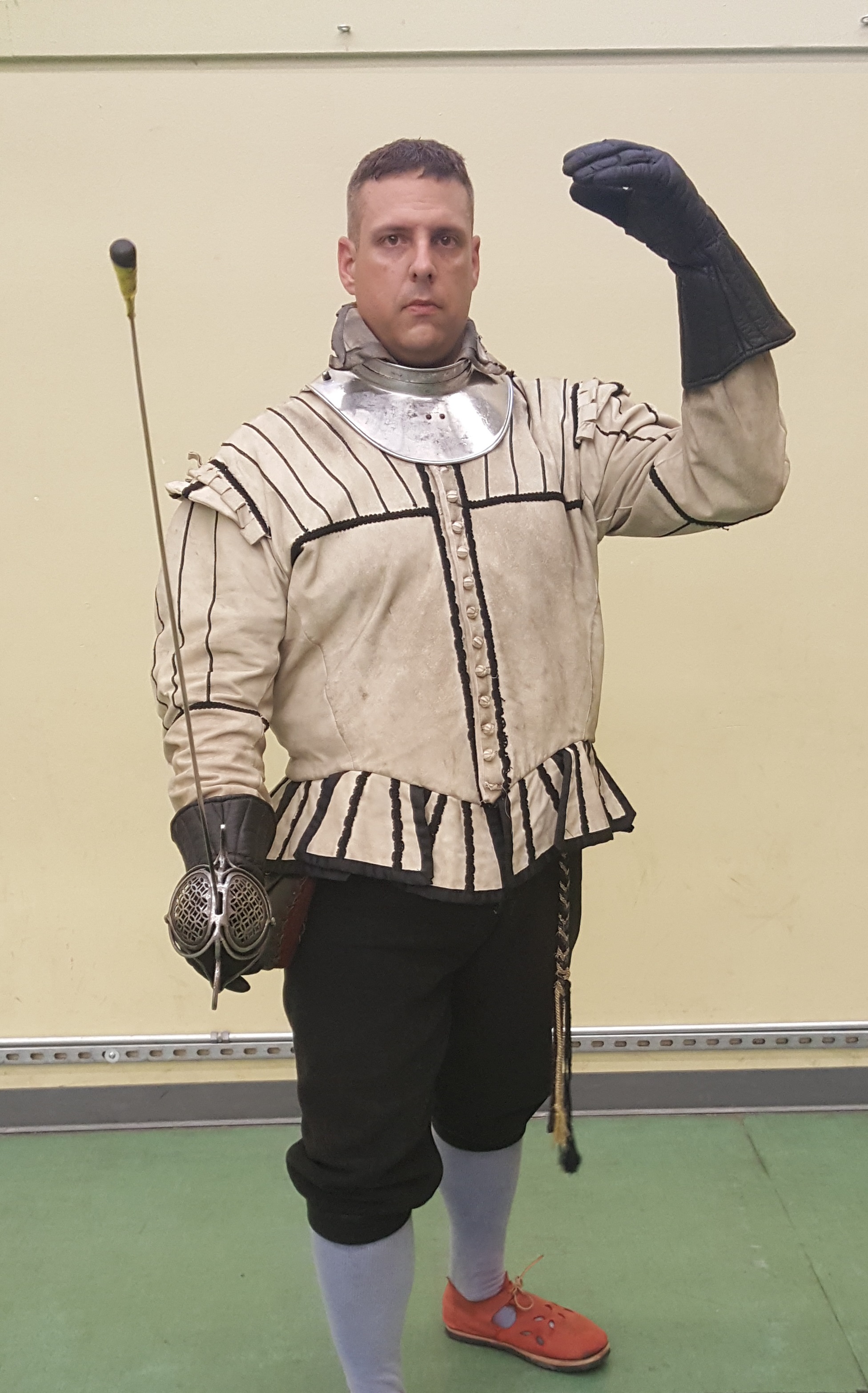 Low Extended Ward: Saviolo's version of the code lunga stretta, and sometimes alta; and could be similar to Silver's variable ward Low Extended Ward: Saviolo's version of the code lunga stretta, and sometimes alta; and could be similar to Silver's variable ward |
UNDERSTANDING TRANSITIONS
Transitions are actions between presentations. If you are moving, it needs to occur with a purpose. Don't waste movement. Don't move randomly. If you can't say exactly what reason you have for a movement, examine why you are doing it. As a general rule, who ever initiates tempo in measure is going to get hit. Alternatively, you can hit someone easier when they are moving and in measure; and they are neither attacking or defending. Hence, your transition should either be an attack or defence, or a tactical re-alignment.
Transitions will therefore be broken down into either an attack, a parry or a remove and/or re-alignment. Random movement with no purpose is a very bad idea. If you are going to transition between a ward or a guard, best do so as an attack, or while defending!
Deciding how to make a transition is a where the factor of tempo comes in. Tempo, is a the time it takes to do a thing. But what thing? If the acting theory we have is to stand on the surest ward and allow the opponent to make the first move, that means that the transition is going to be reaction. The tempo, is set by the opponent in this case. How to react then comes down to the time it takes to respond. That's a complicated way of saying parry the attack and try to make a hit.
THEORY OF ACTIONS
Distinctions of Parries Beat vs. Glide
CUTTING INTO A THRUST AND THRUSTING INTO A CUT
Stesso Tempo
This action is two-times. Let's take a hypothetical cut. The ideal example here is to thrust into the cut (aim for the hand), without any intent on the thrust to strike the opponent, you mainly are just going to want to stop the cut. The entire purpose of the trust is to put aside the sword. The thrust actually converts to an opposition position, with the swords maybe at 90 degrees to each other. Once the sword attack is totally neutralized, a counter cut might be used, or if you have the line, you can roll the hand into a thrust position and continue. Further, you can replace with a dagger or off hand, and keep the control, and strike a cut or thrust freely. In Olympic fencing, this is actually expressed as the "Right of Way" concept where the opponents attack is neutralized first, and then a counterattack found. The worst case in this action is that the defense is successful, and no counterattack found. If that occurs, you at least have countered an attack. Here are some actions, which I'll note, if your first action is a thrust, it's typically countering a cut, and vise-versa.
Falso Dritto and Falso Manco
These cuts are done at a 45 degree angle, using the false edge of the blade, against the debolay. The
falso dritto starts on the fencers right and cuts up and to the left. The falso manco
is also done at a 45 degree angle, but cuts from the let to the right.
Think of the starting point as hip to shoulder, opponents left hip to
right shoulder and right hip to left shoulder respectively. They are
also considered half tempo actions.
Understanding timing on a parry is important to proper execution. Parry too soon and you your opponent may just go around. Parry too late, and well, it's too late. The safest place to parry a sword to is going to be Outside Of Presence, that is to say "Far enough away as to not hit you in a tempo." This can be accomplished with either a beat which drives the sword far away, or a glide which offsets the sword. In either case, the purpose is to first not be hit and the second purpose is to seek to gain some advantage.
Knowing your body space is important. Parry only as far as you need. In some cases you, or your opponent may use tactics that result in an over parry, where the sword goes too far away from the fencer, and uncovers themselves. If that happens, re-directing the attack to the newly exposed area can be very profitable.
This is a basic parry used in a lot of actions. It's a parry to the outside. We will use codelunga stretta, or codelunga alta. In a "Classical" system you can use Parry 3 or 6. Use this as a warm up drill. The parry should be realistic and in the right tempo. Agent should try to hit the target. The attack is a straight thrust right down the middle.
The inside line of this parry-riposte may see an additional pivot with the hips a little to work the body around the tip. If a fencer is squared to the opponent more, there may be more of a need to throw a little void in with the parry. As always, it's a good idea to do this, since it would not be wise to just say that a parry alone is enough to keep you safe. In doing voids, the footwork is not as defined as advances and passes are. You'll need to use what works, but don't over do it, and try to keep the tip of the sword always in the face of the opponent.
Instead of an attack in Secunda, we will use a terza thrust to the upper body, in order to give more space to show this correctly. The fencer will be putting the sword off to their left, and it will be readily apparent how this sets up for an offhand control, which will maintain the contact (thus stopping any ability to do something with the sword).
Start with an Agent and a Patient
Dui Tempo
The simplest to learn will be how to Parry In Opposition. It is a parry that puts as much steel between you and your opponent as possible. Often delivered at 90 degrees to the blade, it can nearly grantee that no further aggression can be delivered by the opponent. It also means the same for you too. This is a
favorite parry of the period English master, George Silver. He stressed that the best reason to make this parry is to be safe. He felt that the first and most important thing to take care of in a sword fight was to neutralize your enemies attack. In so doing, you took no chances and stayed alive. He did not believe in risky
behavior seen by the Italians (by his own definition of what was risky, mind you). The general terms for this kind of parry is a Dui Tempo, or "Double Time" which means it takes doing two things to hit:
one time to parry, and a second time to respond. He did understand that
timing was very important to a fight. Parry too soon, and you give away
your intent to the opponent. Parry too late, and well, you die. The most
important thing that can be said of a parry in opposition is that it does
buy time to do something else. For the English, this might well be a kick,
a punch, or some sort of grapple.
What are the flaws? Well, to be sure, a Dui Tempo parry will most always keep you safe,
but may not set you up for a riposte. The trick on these actions are
to use the time created with the first half of the action to execute
control over the other guy's blade and see some kind of advantage to attack.
Mezzo Tempo
With a
mezzo tempo action, you might very well fail to control the blade and kill yourself as you go to get the other guy.
The mezzo action happens before the opponent can set up and deliver, it is
almost like a quick draw, hit first kind of action. Silver, apparently was aware of this exact and very same problem that existed with the body of Italian fighting, in that he advised to not go running at each other upon the other's point. If you make a
judgment error here, you will probably lose the bout. This means too that mastering a
mezzo tempo took much time and practice. It is much harder to do right, but will end a fight much faster. Even in the first exchange. This was seen in period too, as some Italian duels ended very quickly. This concept was further refined by Cappo Ferro, who had a basic "One Shot One Kill" policy when it came to sword play.
Basically the adage of "Giving a little to get a little" works here. Unless you are willing to put yourself at risk, you can't really end a fight.
The action, either a parry or an attack, initiates without a commitment
from being shown from the opponent. You can attack without covering
their blade, or attack while covering the blade, but in either case, it's
typically with little clear indication of what the opponent is doing first.
Stesso Tempo
The
most Italian of parries is the Stesso Tempo. Stesso tempo is get
there when they do. Not before. Not after; but during. The end result is
that the defender both removes the threat and makes an attack within the
same tempo. Stesso tempo is not as athletic as a mezzo will need to be, but it is calculating and careful.
The biggest expressed risk in a proper stesso tempo is to understand that normally within the execution of the
action, there is a point at which the body is placed at risk of a hit. It's a minimized risk, but it is there.
The "trick" as it were is that the opponent sets the tempo and the stesso
action (defense combined with attack) is done WITHIN the time from the
opponent.
A Beat Parry is going to be used to forcibly and quickly expel the opponent's blade. This kind of parry can be hard on a sword, leave chips on the blade, and should be done edge to edge. It can also be referred to as an Expulsion. It is best to parry on the false edge, but it's not always the case.
Many use the Falso Manco and Falso Dritto as the beat parry, using the false
edge. You will see others use the true edge. Again, either is a
half tempo action.
A Gliding Parry can also be used in most of these parries, but it is gentler. It starts with little pressure on the blade and as the parry is carried along, pressure increases until the parry is fully executed and the opponent's blade rendered useless. It can most often be introduced first when Stringering the blade. There are many examples to be found in Capo Ferro's works.
I'll explain how these actions might be used. Under ideal conditions, a thrust is answered with a cut, and a cut is defeated by a timely thrust. Mechanically, either of the actions you need is going to be both defensive and offensive. If the stesso tempo cut is used, it is probably a half tempo and is thrown so that it cuts against the blade, and sets a thrust as a finish. If the stesso tempo action is a thrust, the thrust both deflects the cut and terminates in a cut. The difficult part is knowing what kind of action to use. This is judgment. Here is a a typical breakdown of what is used to counter what.
Half dritto defeats a stoccota
Falso manco defeats a stoccota
Falso dritto defeats a stoccota
Roverso dritto defeats an imbroccata
Push Cut defeats an imbroccata
Guardia d'intrare defeats a roverso dritto
Inside guardia di testa defeats dritto
Guardia alicorno defeats fendente
Mezzo Tempo
The mezzo tempo action can set up an effective defense. The thing is that there may not be contact with the opponent's blade. There may be, and it's ideal to set this up with the intent to close the line of the sword. It should be thrown with the intent to cut off the coming attack from the opponent. Mezzo tempo here is that the action is thrown prior to the true intent of the opponent’s attack being known. You might think of this as fast Olympic fencing kind of attack that hits in an absent time or in between tempos. It's fast, and the problem is that if you do this at full speed, you might not actually stop the counter since the success of the attack is assumed to stop the opponent. It's mostly never a cut because cuts take time. In most cases, the action is going to happen just when the opponent initiates tempo, or fails to respond to a tempo. Here are some actions you might consider for this kind of thing.
Stop thrust with remove
Imbroccata and left pass
Stoccota and incartata
Straight thrust
Falso to guardia di facia
Punta dritto with right pass
Dui Tempi
Thrust to true guard then dritto
Thrust to hanging guard then roverso
Thrust to codelunga larga then montante
Cut to guardia di testa and dritto
Inside guardia di testa and stoccota to face
Cut to guardia di fianco and roverso dritto
Contra Tempo
"let him beware that he doo not beate aside his teachers weapon toward the point, because he shoulde be in danger to receive a thrust or stoccata either in the face or belly."
With mezzo tempo, stesso tempo and dui tempo, the assumption is that the fighter is patient and waiting for the opponent to reveal their intent and the counter takes advantage of it. It can be difficult to predict, so you can actually manipulate them into an action. Let's say that the fencer wants the opponent to strike a stoccata that can easily countered within a false edge cut and a thrust to follow up. If the fencer causes the opponent to react with the expected thrust by over parrying and exposing the body to a stoccotta or offering a thrust (recall that Saviolo likes to respond in kind when attacked) as a response; it can be thought of as Contra Tempo. The fencer is first drawing out and provoking what they hope is an expected response from an opponent.
This kind of action sets the tempo for the opponent's movement.
Here's some things that use counter time.
Counter cravasion in quarter
Receive a thrust with a void, return thrust in counter time
Attack with a feint, so to expose the sword arm, then stop thrust when they counter attack
Open with falso tondo to provoke a reaction, thrust at what moves
Counter cravtsion, and wrist cut
Counter a stoccota with a falso manco
Counter an imbrocotta with a faslso dritto
Opponent disengages under, counter the action with a falso manco
Opponent thrusts a high point guadia defacia, counter with a falso dritto
Disengage under the opponent, use a falso manco as a beat parry
Movement Drill: Parry to the Outside
Start with an Agent and a Patient.
-Both start in terza
-Agent thrusts and steps out 12 inches (or the length of a foot or so)
-Agent aims to land the tip on the exposed forearm on the outside line of the Patient in secunda
-Agent, mind the timing. Land the tip on the target when the foot lands.
-Patient will parry turning the hand from terza to secunda and pushing the wrist out slightly to catch the edge of the Agent's blade
-Patient must keep the tip in the face of the opponent with this parry
-Agent assembles back to Neutral in terza
-Do 20 reps of this drill and switch
When doing advanced versions of this drill, stick to attacking in imbroccata, that is a thrust in prima or secunda to the arm and upper body. Add foot work. Use Slope Paced Steps, use Volte, or incartata to try different types of footwork to reach the opponent.
Movement Drill: Parry to the Inside
"You maie also offer a false thrust at his face, and if hee go about to strike it by with his Rapier, you maie put your pointe under his Rapier, and carrying your right foot side-waie, give him a stoccata in the bellie"
The second parry of this type is going to be to the inside line. I like to call these "Bread and Butter" parries, in that in one form or other they can do a lot to deal with thrusting attacks. As noted before, we build off of previous drills. We will use the Short Measure Thrust, but once these parries
are well practiced, any of the movements shown in part III can be used here.
Starting in Terza, the agent is going aim for the belt buckle. The patient will need the deflect the trust only as far as needed to avoid being hit. Rotate the wrist to a quarta, only enough to use the edge for the parry, going to chingera porta deferro alta or stretta, as you see fit. Historically, the chingera also are only done with the left in lead, but for this, it need not be.
-Both start in terza
-Agent thrusts steps out 12 inches (or the length of a foot or so)
-Agent aims to land the tip in on the belt buckle
-Agent, mind the timing. Land the tip on the target when the foot lands.
-Patient will turn the hand from terza to quarta (four) and push the tip outside to the left.
-Agent assembles back to neutral in terza
-Do 20 reps of this drill and switch
Both of these drills can be
practiced with taking all the foot movements from Part III in
combination of the attack. For historical nuance, there are
different methods to explain the hand position of the executed
parry. It can be in "Classical Fencing" terms of parry 6 and 7/3 or
4 or in historical terms of codelunga and porta de ferro. Further,
there is some nuance to the position of the edge of the blade. Use
the edge to parry, never the flat. You might not have to turn the hand to the defined 1, 2, 3, or 4th positions. You can use a variable of that, called a Mutation, which is going to be something halfway between. Situation will dictate but it is important to note that this is specifically an edge on parry. Use what will work for you, but understand the concepts being shown here;
parrying to the outside line, and
parrying to the inside line. Attacking with an imbroccata and attacking with a stoccota.
Movement Drill: Outside Line Parry-Riposte
"Againe to the purpose: If your enemie make towardes your right side, and offer a thrust, happilie pressing too much forward, you shall immediatelie turne your bodie on the left side, so that the point of his Rapier passing beside your bodie, you maye give him a stoccata: or you may plaie with your bodie, and beate his Rapier pointe outward from your right side wyth your Dagger, and give him a punta riversa over his Rapier in the belly or face. Or also while hee thrusteth, you may beate it by with your Dagger, and carrying your right foote towarde his right side, give him the same thrust"
Let's build on the first two drills here. We will now combine more foot work and a riposte with each
defense. There is going to be a little bit more play with the foot. Let me also take a minute to introduce a nuance in the fight. Pivoting around the sword. In the first instance, if catching a parry to the outside line, twisting the hips with the upper body to the right, in time with the parry can help throw a little bit of a body void in with the counter. It is always a good idea to not just rely on the parry for protection. Twisting a little or moving forward or backward as tempo and measure dictate is always advised. In the quote above, this is a kind of drill done with dagger, but a second control with the dagger, or the offhand or a control with the blade, the motions with body and foot are the same. Remember, it is an important element when layering all this together that each kind of act is self contained. You should be able to do the exact same kinds of motions with the sword regardless what your secondary is. One constant that Saviolo has in much of his work is to return shot for shot. If you are attacked with a stoccata, return with a stoccata, etc.
Start with an Agent and a Patient.
-Both start in terza
-Agent thrusts and steps out 12 inches (or the length of a foot or so)
-Agent aims to land the tip on the exposed forearm on the outside line of the Patient in secunda
-Agent, mind the timing. Land the tip on the target when the foot lands.
-Patient will parry turning the hand from terza to secunda and pushing the wrist out slightly to catch the edge of the Agent's blade
-Patient must keep the tip in the face of the opponent with this parry, and slip a little back with the lead foot to the right
-Patient gains a control with the sword, mindful to catch the tip on or near the hilt
-In the next tempo, Patient returns the same shot delivered; imbroccata in secunda
-Do 20 reps of this drill and switch
Movement Drill: Inside Line Parry-Riposte
-Agent thrusts in terza and steps out 12 inches (or the length of a foot or so) aims for the belt. Tip should land with the foot
-Patient will turn the hand from terza to quarta and catch the tip near the hilt and push it outside to the left.
-Patient will take the next tempo and while maintaining contact counter thrust in four to the Opponents belt buckle
-Optional: Patient uses an incartata with the counter thrust
-Do 20 reps of this drill and switch
Movement Drill: Mezzo Tempo
For the next four drills we are similar to the thrust and riposte drills. This time, instead of absorbing the thrust into a parry, the fencer will execute a falso manco against the Forte of the opponents blade. Both fencers will be in Terza, and we will once again use the Agent/Patient method of breaking down the drill into easy steps. The patient will attack as fast as possible. The part that is supposed to keep the Agent safe is the beat clears out the attack and the counter is so fast that the opponent can't find the time to line up for a new shot.
Start with an Agent and a Patient
-Both start in Terza
-Agent steps out 12 inches (or the length of a foot or so) and trusts an imbroccata (use secunda) to the Patient's arm
-Patient will bring the sword to inside the left of their body and sharply cut up and out to the right with the false edge (Falso Manco)
-IN THE SAME TIME the patient will advance to close the distance so that as the false edge cut terminates with the tip is within 6 inches before the Agent's mask
-Patient will be in secunda as well
-Patient will just have to drop the tip and extend slightly to touch the Agent's mask
-Do 20 reps and switch
Movement Drill: Stesso Tempo
While it may seem that this needs to be done very fast, it is not actually the case. Do not sacrifice control for speed. In this kind of attack, staying safe is the actual purpose of the drill, not seeing how fast to hit. This method of movement is probably one of the most difficult to understand since it is not just hit the other guy first. You need to both defend and counter hit with clear control. You may not actually know where the opponent was going to try to attack. The attack to the opponent is launched at the instant they initiate tempo, but not before, and definitely not after.
Start with an Agent and a Patient.
-Both start in terza
-Agent steps out 12 inches (or the length of a foot or so) and trusts an imbroccata (use secunda) to the Patient's arm
-Patient will bring the sword to inside the left of their body and sharply cut up and out to the right with the false edge (Falso Manco)
-IN THE SAME TIME the patient will seek out the displaced sword of the Agent,(using secunda) with the purpose to maintain blade contact
-Patent will keep the tip pointing to the mask of the Agent
-AS CONTROL IS GAINED, Patient will extend with a Slope Paced Step Left and thrust an imbroccata to the Agent
-Do 20 reps
Movement Drill: Dui Tempi
This one is going to be a little more difficult get down. The transition is a little more difficult. The tip will come off line and it really makes
sense to do this drill using a secondary of some sort. Prior to doing so, the primary set up movement with the sword will need to be well understood.
Start with an Agent and a Patient.
-Both start in Terza
-Agent steps out 12 inches (or the length of a foot or so) and trusts a stoccotta to the upper chest
-Patient will widen out the terza position and with the left foot, and go a little like an incartata to help position the body
-Patient, as soon as the slight void and re-position is done, cut a falso dritto
-Patient follows the clearing cut far over to the left, crossing the arm over the body
-Once cleared, it should take a full tempo
-Patient will transition the blade from edge on parry to thrust in terza. If an offhand is used, it would not be maintaining the control of the Agent's blade
-Patient will advance as needed to close distance and thrust terza to the Agent
-Do 20 reps
When tempo is established, it can be used against the fighter
who starts it. Here, we will provoke a tempo, in order to act in a
counter time. This starts with a feint at not the fastest speed,
to garner a return in the same tempo. Then a removal of the target
and couter with a control. Keep this on the outside line of the
Agent.
-Both start in terza
-Patient thrusts a secunda to the Agents arm/elbow on the top of the arm
on the outside line
-Agent parries the thrust at the same speed as the initial attack
-Agent counter thrusts to the Patient's outiside line (returns the same
attack)
-Patient will react by pulling the hand in and to the left to remove
the target; and get the Agents tip on the forte
-Patient will then counter the Agents attack, stepping with the left
foot on a slope pace
-Patient will turn the thrust to a secunda and control the Agent's
blad all through the counter to touch
-Do 20 reps and switch